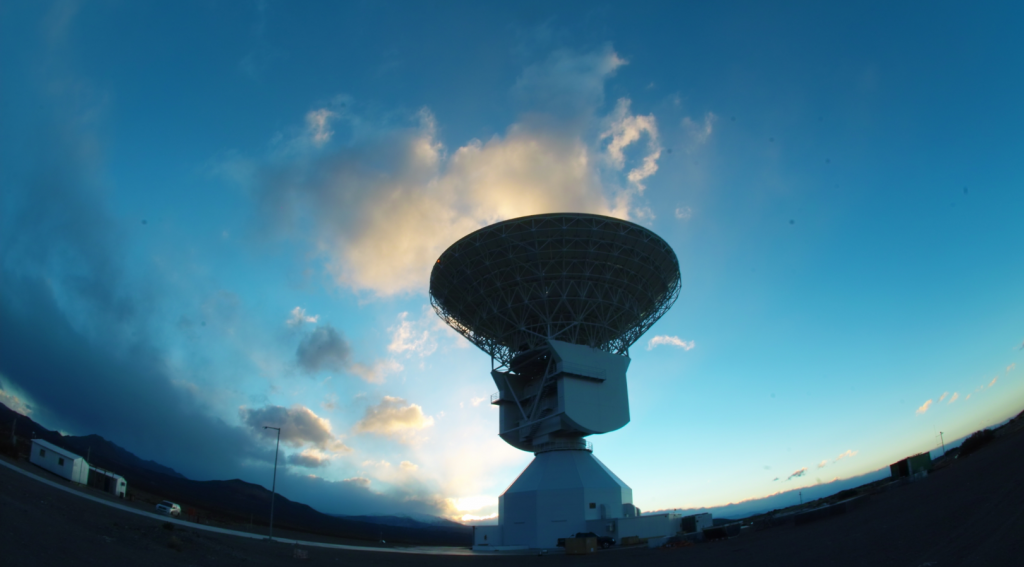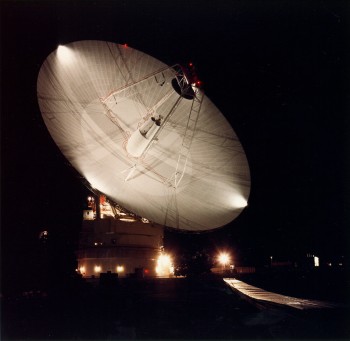One fascinating aspect of Rosetta operations is telecommunications: specifically, how mission controllers at ESOC are communicating with the intrepid spacecraft.
The ESA tracking station network – Estrack – is a worldwide system of ground stations providing links between satellites in orbit and our operations centre at ESOC. The core Estrack network comprises 10 stations in seven countries.
The essential task of all ESA tracking stations is to communicate with our missions, up-linking commands and down-linking scientific data and spacecraft status information. Estrack stations also gather radiometric data to help flight dynamics teams and mission controllers know the location, trajectory and velocity of their spacecraft.

One of the world’s most sophisticated satellite tracking stations is nearing inauguration in Malargüe, Argentina, 1000 km west of Buenos Aires. The new station will ensure reliable communications with missions voyaging hundreds of millions of kilometres into our Solar System. ESA’s new tracking station, near the town of Malargüe in Mendoza province, joins two existing stations in Spain and Australia to provide global coverage for the Agency’s deep-space missions. Credit: ESA
For missions like Rosetta, Mars Express, Venus Express and Gaia, we routinely use Estrack’s three 35-m deep-space stations (referred to as DSA – for deep space antenna), one each in Australia, Spain and Argentina. These fulfil most of our tracking requirements.
| Network | Station | Location | Country | Dish size |
| ESA/Estrack | DSA 1 | New Norcia | Australia | 35m |
| ESA/Estrack | DSA 2 | Cebreros | Spain | 35m |
| ESA/Estrack | DSA 3 | Malargüe | Argentina | 35m |
In addition, Rosetta is using a mix of NASA ground tracking stations (including a 70m terminal from the Deep Space Network DSN) to ensure availability and redundancy; the overall list includes:
- 34m stations: DSS-15/24/26 in Goldstone, California
- 70m stations: DSS-63 in Madrid; DSS-14 in Goldstone, California
Cooperation provides coverage
This list refers to the arrival timeframe 24 Jul – 10 Aug only. Other stations are being used at other times. The actual station used varies depending on real-time allocations by the Agencies’ tracking planners; Estrack scheduling is done 6 months out, while DSN scheduling is on a 3-month forecast.
For example, during arrival on 6 August, tracking will be provided by ESA’s New Norcia station, which will acquire Rosetta starting at 10:00 CEST (just before the arrival manoeuvre starting at 11:00 CEST on board). But, just before that, tracking will be provided by NASA’s DSS-15 station at Goldstone, between 04:50-09:35 CEST.
Susan Kurtik, the Mission Cross-Support Manager for DSN at NASA/JPL, explains that this collaboration is part of the long-standing, mutual cooperation between the ESA and NASA deep-space networks, enabling continuous tracking of each Agency’s spacecraft when not otherwise possible and reducing risk for the most critical mission activities.
“DSN has been providing tracking support for the Rosetta spacecraft for over a decade. It has been an honor for NASA/JPL to be a part of this amazing mission,” she adds.
Rosetta tracking by the numbers
We asked Gabriela Ravera, an Estrack engineer and the Rosetta Ground Operation Manager at ESOC, to provide a few details on Rosetta tracking just before arrival.
How fast does Rosetta transmit data to Earth?
Here are the Telemetry (downlink) bit rates used by Rosetta until the end of the year:
| Thru to 20 Aug: | 45706.1079bps |
| 21 Aug until 23 Sep: | 38088.4232bps |
| 24 Sep until 18 Nov: | 28566.3174bps |
| 19 Nov until 23 Jan(2015): | 22853.0539bps |
And what’s the bitrate with which the tracking stations transmit to Rosetta?
The uplink telecommanding (TC) bit rate is 2000bps.
When Rosetta transmits a signal via its on-board high gain antenna (HGA), what’s the initial power radiated?
The effective isotropic radiated power from Rosetta (HGA in X-Band) is 57.4dBW (approximately 548,276 W).
Wow! That sounds like a lot! How much of that signal actually gets here? Rosetta and the comet are still about 2.7 AU from Earth this month…
Once the signal arrives on Earth, it will have been reduced in power proportional to the square of the travelled distance. At Rosetta’s current distance (2.7AU), the received power will be -225.69 dBW or 2.7E-23 W – an extremely small signal level which is just 0.0000000000000000000000270 W!
Can we receive such a tiny signal?
Yes; taking ESA’s New Norcia 35m station as a reference, and thanks to its 1000m2 antenna collecting surface and gain of 68.3dBi, Rosetta’s weak signal is captured and results in a received power of -157.38dBW or 1.83E-16W. This is still very small – just 1.83 femptowatts. The use of cryo-cooled low noise amplifiers working at -260oC allow the detection of such signals.
Note: see “Low noise amplifiers” – Ed.
What every-day electronic item uses such a tiny level of power?
If you wish, you can compare it to the average received power of a GSM mobile, which is approximately -80dBm or 10pW with an antenna of just a few cm2. Therefore, Rosetta’s signal is approx. 5000 times weaker.
And how do we get signals from ground up to Rosetta?
In order to cope with the (really big) distance between Earth and Rosetta, our 35m antennas can transmit signal with a power of up to 20kW, which is approximately 80,000 times the average maximum transmitted power of a GSM mobile phone (0.25W).










Discussion: 12 comments
The onboard Rosetta coms is 1993 vintage h-ware, but ground stations have been continuously improved since then. Does this result in better actual download performance than originally designed for?
This reply sent in by Gabriela:
The downlink telemetry bit rates available for Rosetta were chosen and designed so as to cope with the maximum Earth distances achievable by Rosetta during its mission life. However, thanks to the improvements carried out in the ESTRACK ground stations (i.e. a new generation of cryo-cooled low-noise amplifiers that went from a noise temperature of 12 oK (-261.15oC) to 6 oK (-267.15oC) ), the figure of merit G/T of our ground stations have improved in the past years around 1 dB (Clear sky). This translates into a 25% data rate increase! As a consequence, at a given distance Rosetta benefits from it and it is now able to use higher TM bit rates than originally planned. Currently, the link budget is being monitored and adjusted to take the maximum benefit of any improvement experienced on the downlink.
Regards, GR
Just curious, does the signal strength loss happen due to the solar n other cosmic interference or due to the earths atmosphere ?
Really great article, it’s rare to see such technical details discussed, but to me this text rode the fine line between interesting and too much perfectly! Thanks a lot for that!
Can the station on Malargue be visited ?
Carlos / Buenos Aires
Great post! Amazing we can receive signals that weak.
Thanks for such technical details on communications
The comet in rotation looks like an intertrochanteric fracture fragment with an intact femoral neck and femoral head, with the foveal pit.
I wonder if this is a stable geometric configuration.
For future refrences, would it make sense (if money would not be an objection) to built a relay station e.g. at any of Lagrangian points? Enabling higher gain antennas and also allowing better link budget in absence of the atmosphere.
Fascinating, but I am curious: With all the mirrors and reflectors to get through, how much signal loss is there between the rf generator and actual transmission?1409
Thanks for the interesting information – what is the bit rate and trasnmit power to/from Philae?
thanks
Very interesting, I was finding it difficult to get more detailed information on the links before finding this. Thanks for the effort!